|

Memorandum Number One:
An Introduction to the Secret Cult of the
Order
Secret political organizations can be - and have been - extremely
dangerous to the social health and constitutional vitality of a
society. In a truly free society the exercise of political power
must always be open and known.
Moreover, organizations devoted to violent overthrow of political
structures have always, by necessity, been secret organizations.
Communist revolutionary cells are an obvious example. In fact, such
revolutionary organizations could only function if their existence
was secret.
In brief, secrecy in matters political is historically associated
with coercion. Furthermore, the existence of secrecy in
organizations with political ambitions or with a history of
political action is always suspect. Freedom is always associated
with open political action and discussion while coercion is always
associated with secrecy.
There are numerous historical examples to support this premise. Back
in the late 17th century the Elector of Bavaria, the constitutional
government of Bavaria, banned the Illuminati organization.
Accidental discovery of Illuminati documents demonstrated that a
secret organization was devoted to the overthrow of the Bavarian
state and establishment of a world society run by elitist
Illuminati.
More recently in England there have been startling discoveries
involving use of the Masonic movement by the Soviet KGB to subvert
and infiltrate British intelligence. True freemasonry is an
establishment conservative organization, but its organizational
structure can be - and has been - used for revolutionary purposes.
Masonic aims are publicly stated to be fraternity and charity, but
it is also well known that masons help each other in areas
supposedly based on talent.
In The Brotherhood 1
Stephen Knight comments that many have suffered
because freemasonry has entered segments of society where it has no
place:
... there can be no doubt that many... have suffered because of
freemasonry entering into areas of life where, according to all its
publicly proclaimed principles, it should never intrude. The abuse
of freemasonry causes alarming miscarriages of justice" (p. 4).
1 Stephan Knight,
The Brotherhood: The secret World of the
Freemasons, Granada, London, 1984.
In England at any rate freemasonry has become a self-serving
organization always discriminating in favor of its own members when
it comes to contracts, jobs, careers and promotions. Moreover, we
now know that the masonic movement in England was used by the
Russian KGB to infiltrate, take over and finally head British
intelligence organizations.
In September 1984 Scotland Yard in London advised all its police
officers not to join the freemasons lest its reputation for
impartiality be lost. Given this background, The Order, a secret
society also known as Skull & Bones, is a clear and obvious threat
to constitutional freedom in the United States. Its secrecy, power
and use of influence is greater by far than the masons, or any other
semi-secret mutual or fraternal organization.
How secret is Skull & Bones?
The most careful analysis of the society is by Lyman Bagg in
Four
Years At Yale written in 1871, and still the only source of
documented information on the cultic aspects of The Order.
According to Bagg, The Order is intensely secret:
"They (the senior societies at Yale) are the only Yale societies
whose transactions are truly secret."
"Their members never mention their names, nor refer to them in any
way in the presence of anyone not of their own number, and as they
are all seniors, there are no old members in the class above them to
tell tales out of school."
This intense secrecy even extends to documents printed for internal
use. On the next page we reprint an internal circular distributed
among Patriarchs which has disguised references as follows: "P"
i.e., Patriarch "P---s" Patriarchs. If The Order has this intense
secrecy, then how are we able to reproduce its documents and
memberships rolls? Simply because secrecy attracts attention.
Secrecy creates suspicion of intentions. This in turn generates
action to break the secrecy.
This series of books is based on several sources, including
contemporary "moles." However, information on the cultic aspects
comes from a century-old Yale concern about the operations and
intentions at Skull & Bones. This concern generated two pamphlets,
one issue of a journal and a chapter in a book, as follows:
An anonymous pamphlet entitled Skull & Bones. This is an account
of the 1876 break-in at the "Bones" Temple on the Yale campus.
1.-
Lyman Bagg, Four Years at Yale
Henry Holt & Co., New York, 1871
The chapter "Senior Societies" is reprinted in full as an appendix
to this book.
An extremely rare document, it is reproduced in full as an appendix
to this book.

The pamphlet begins:
"As long as Bones shall exist the night of September 29th (1876)
will be to its members the anniversary of the occasion when their
temple was invaded by neutrals, their rarest memorabilia confiscated
and their most sacred secrets unveiled to the eyes of the
uninitiated."
This is reference to a break-in by a group of Yale students, and the
pamphlet describes in minute detail the contents of the Temple. For
example, it describes the walls, e.g.,
"... the walls are adorned
with pictures of the founders of Bones at Yale and of the members of
the Society in Germany when the Chapter was established here in
1832."
This sentence becomes of interest when the Illuminati aspect is
discussed in Memorandum Five below.
Here's another interesting paragraph from this pamphlet:
"Bones is a chapter of a corps in a German University. It should
properly be called, not Skull & Bones Society but Skull & Bones
Chapter. General R------ (Russell), its founder, was in Germany
before Senior Year and formed a warm friendship with a leading
member of a German society. He brought back with him to college,
authority to found a chapter here. Thus was Bones founded."
Think about this: Skull & Bones is not American at all.
It is a
branch of a FOREIGN secret society.
Presumably this is one reason why intense secrecy is vital. It also
raises the question of just who and what this foreign organization
is and whether its objectives are compatible with those of the
Constitution of the United States.
2.- The Order, The Fall of Skull and Bones
(New Haven, 1876)
This is
an anonymous satire published 1876 apparently in New Haven,
Connecticut by a group calling itself The Order. The subtitle reads
"Compiled from the minutes of the 76th regular meeting of The Order
of the File and Claw." The opening paragraphs are as in Skull &
Bones cited above (1).
However, the text continues with considerably
more detail and appears to have been written by another member of
the break-in crew. In particular, this book gives the identification
of the owner of the human skull found in one of the rooms of the
Temple:
"A light is always kept burning in the Jo (D) which is ornamented
with a dilapidated human skull ... here is also a tombstone marked
SPERRY, seemingly taken from the same grave as the skull."
In brief,
it appears this "respected" Order of Yale gentlemen is no more than
a coven of grave robbers hoarding skulls, skeletons and tombstones.
Then further down is the following:
"In the Pantry (F) are large quantities of dishes, each piece of
crockery ornamented with a picture of a skull and crossbones, each
spoon and fork marked S.B.T."
(Skull and Bones Trust)
This suggests a preoccupation with skulls and human bones is built
into the cultic structure of The Order.
Then on page 4 we learn that each member of
Skull & Bones (as well
as Scroll & Key) has an "inside name" and these names bear a
remarkable resemblance to those used by the Illuminati, e.g., Chilo,
Eumenes, Glaucus, Prisaticus and Arbaces.
The conclusion of this pamphlet is:
" ... we will say that a thorough examination of every part of the
Temple leads us to the conclusions that the most powerful of college
societies is nothing more than a pleasant convivial club."
This
conclusion ignores other evidence presented elsewhere. It is
acceptable given only the findings of the break-in crew.
3.- The Iconoclast
New Haven 1873
Only one issue of this journal has been found, and only a single
copy of that issue exists. It is reproduced as an appendix below.
The editor of The Iconoclast considered Skull & Bones "a deadly
evil" and emphasized their interest in political control.
Moreover,
the Iconoclast states that The Order obtained control of Yale, and
its members care more for their society than for Yale:
Out of every class Skull and Bones takes its men. They have gone out
into the world and have become, in
many instances, leaders in society. They have obtained control of
Yale. Its business is performed by them.
Money paid to the college must pass into their hands, and be subject
to their will.
4.- Chapter "Senior Societies" in Lyman Bagg, Four Years at Yale
This is the reference cited above at the beginning of this chapter.
Other sources include an article in Esquire Magazine by Ron
Rosenbaum entitled "The last secrets of Skull and Bones" (September
1977).
From this article we learn such tidbits as:
"Supreme Court Justice Potter Stewart ... dressed up in a skeleton
suit, howled wildly at an initiate in a red
velvet room inside the tomb"
"McGeorge Bundy wrestled naked in a
mud pile as part of his initiation."
According to a dossier obtained
by Ron Rosenbaum, the 1940 initiation ceremony went like this:
New man placed in coffin - carried into central part of building.
New man chanted over and reborn into
society. Removed from coffin and given robes with symbols on it
(sic). A bone with his name on it is
tossed into bone heap at start of evening. Initiates plunged naked
into mud pile.
Again, we have a sordid preoccupation with coffins, skeletons and
death.
This about summarizes sources of information.
Strangely enough, the long-time proponent of conspiracy theories,
the John Birch Society, has made little contribution to our
knowledge of The Order. Apparently JBS recognizes its existence but
considers it merely a "recruiting ground," which, of course, it is.
This "recruiting ground" interpretation suggests several points.
-
Firstly, the documentary evidence is quite clear: Knights, i.e., the
just recruited initiates, spend only one year as Knights. They
become Patriarchs after leaving Yale and spend a lifetime as
Patriarchs.
-
Second, continual correspondence and meeting as
Patriarchs continues after leaving Yale. In fact, the Deer Hand Club
is specifically for annual meetings of Patriarchs and the Russell
Trust Association is run entirely by Patriarchs.
In brief, the JBS "recruiting ground" theory just doesn't match all
the facts.
Furthermore, The Order is the ONLY fully documented example we have
of a secret society within the U.S. establishment. JBS has never
produced membership lists of any other society and yet seems
unwilling to recognize the existence of The Order.
Similarly,
New Solidarity, i.e., the Lyndon LaRouche outfit, claims
to have exposed The Order back in 1979. Unfortunately, neither
Lyndon LaRouche nor anyone else can produce documents dated 1983 and
1984 in 1979. In any event, the degree of documentation in our
volumes on The Order has not been matched elsewhere.
The answer is
that this author does have - and fully admits to having -
clandestine sources within The Order. We understand that for
specific reasons these sources are not available to either JBS or
Lyndon LaRouche. At that point we will leave our discussion of
sources and move on to the ritual aspects of The Order.
Return to Contents
Memorandum Number Two:
The Organization of The Order
The Yale Senior society system is unique to Yale University. There
is nothing like it elsewhere in the United States or for that matter
in the entire world. According to Lyman Bagg in Four Years at Yale,
"the senior societies are such peculiarly Yale institutions that it
will be difficult for an outsider fully to appreciate their
significance"
(Bagg, p. 142, see page following for full context)
Nothing like them exists elsewhere and according to Bagg, "Harvard
is the only college where, under similar conditions they possibly
could exist."
There are three senior societies, Skull & Bones, Scroll & Key and
Wolfs Head. Each year 15 male Yale juniors are tapped for admission.
They spend only one year in the society, an entirely different
procedure to fraternal organizations found on other campuses.
Skull & Bones was founded in 1833 and has initiated 15 members each
year since 1833 (except for 1945 when only 10 were tapped). Every
year during commencement week 15 Yale juniors receive an invitation
"Skull & Bones. Accept or reject?" Those who accept, presumably the
greater number, are invited to attend the Bones Temple on campus to
undergo an initiation ceremony. (See next page) Tap day in modern
times is a private, almost concealed operation; it was not always
that way.
Before 1953 juniors were herded into a yard and representatives from
senior societies would circulate among assembled students, selecting
those wanted for initiation.
In those days rejection by a senior society was considered social
suicide, so Yale ordered tapping a private affair, to avoid the
traumatic wait and fear of rejection by the assembled juniors.
For the ambitious, "tapping" is the magic password to a future
career. Wherever he turns, the success of the Yale senior society
system is obvious. Yale University President, A. Bartlett Giamatti,
was a member of Scroll & Key, while George Bush, Vice President of
the United States was a member of Skull & Bones.
The Yale campus student is well aware that the senior society system
is geared to the affluent outside world, to the world after
graduation. Money and connections flow from membership. Reportedly,
Skull & Bones donates $15,000 and a grandfather clock to each
initiate. Certainly alumni pay for everything associated with
society meetings.
In one case reported by New York Times (April 16,
1983), the alumni paid for a three-hour phone call from Colorado to
Yale by two members of Scroll & Key unable to attend a meeting in
the Scroll & Key tomb.
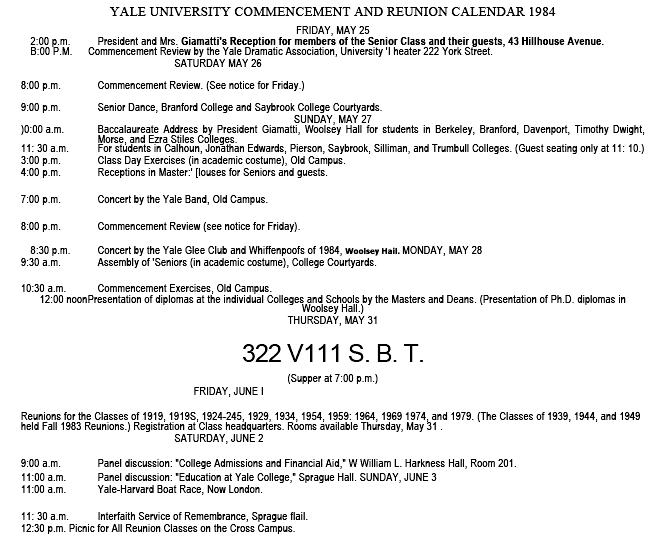
Although the John Birch Society, the long time conservative promoter
of conspiracy theory, emphasizes that these senior societies are
merely recruiting grounds, in effect the societies are the source of
a vast establishment network, a formalized "old boy" network that
effectively shuts out the newcomers and the non-Yale talented from
the halls of power.
Because these are senior societies, the emphasis
is not on campus activities but on post graduation ambitions. That
is the fundamental difference to all other campus societies in the
U.S.
As Bagg points out:
"The statement is therefore again repeated that Bones and Keys are
peculiarly Yale institutions, genuine outgrowths of a system that
flourishes nowhere else, the only organizations of the kind existing
in the country" (p. 183) and the senior society "is an association
with no weak members whatever and the history of the matter shows
that unless this ideal is adhered to with reasonable closeness, such
a society cannot live long at Yale"
(p. 144)
CLUBS OF THE ORDER
Each annual class of new initiates forms a club consisting of 15
members. Initiates are called Knights in the first year and
thereafter Patriarchs. The annual announcement of new initiates has
not varied over the ears. We reproduce on page 194 the
announcement of new members for 1917 and on pages 195-196 those for
1984 and 1985. Each club has a number. This is located in the top
right hand corner Of the announcement sheet (i.e., D 115 for 1917
and D 183 for 1984). Further, one member is designated a "club
chairman" or agent, with the function to act as liaison with the
Secretary of the Russell Trust Association in New York.
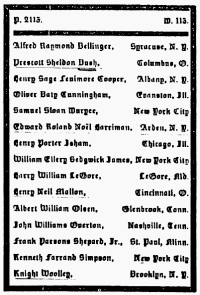 
-
BOASBERG, James Emanuel, 3136 Newark Street, NW, Washington,
D.C.20008
-
CARLIN, William John Carr, Jr., 21 Schermerhorn Street,
Brooklyn, New York 11201.
-
CHANDRASEKHAR, Ashok Jai, 120 East 34th
Street, New York. New York 10016.
-
FRANKEL, Scott David, 3290 Kersdale Road, Pepper Pike Ohio 44124.
-
GROSSMAN, Jay Alan, 48 Niles
Road, Randolph, Massachusetts 02368.
-
KWOK, Wei-Tai, 5 109 Philip
Road, Annandale, Virginia 22003.
-
LINDY, Peter Barnes, 105 South
Perkins, Memphis, Tennessee 38117.
-
MISNER, Timothy Charles, 1009
Crest Park Drive, Silver Spring, Maryland 20903.
-
MNU CHIN, Steven
Terner, 721 Fifth Avenue, New York, York 10022.
-
PATELA, James
Gerard, 47 Knollwood Drive, Branford, Connecticut 06405.
-
POWERS,
Richard Hart, 21 Haigh 06357.
-
SMOCK, Morgan Robert, 4017 Hope,
Minnesota 55427.
-
TAFT, Horace Dutton, 403 St. Ronan Street, New
Haventicut 06511.
-
THOMPSON, Gregory Allan, 118 Whitman Drive, Brooklyn, New York
11234.
-
WALSH, Kevin Sanchez, 1030 Clay Avenue, Pelham Manor, New
York 10803.
THE SECRET CATALOGS
Each member of The Order receives an updated annual catalog of
-:embers. At one time it was a single volume bound in black leather.
CATALOGUE
OCTOBER 1983
VOL. I
LIVING MEMBERS
The latest practice is to issue the catalog in two clothbound
volumes: Volume One for Living Members and Volume Two for Deceased
Members. Preceding is the title page of the October 1983 catalog,
the latest issued. Volume Two is the same with "Deceased Members" in
place of Living Members." Inside the title page is the address of
the Secretary of the Russell Trust Association responsible for
administration of the current affairs of The Order:
"Please send any
corrections or changes of address to: The Secretary RTA Incorporated
P.O. Box 2138 Yale Station New Haven, Conn. 06520"
Then follows an
alphabetical listing of members and brief information on the following: Name and class year with awarded degrees.
A brief notation of occupation, i.e., law, education, finance,
business.
Date of birth is followed by current business and private addresses.
Then follows a list of positions held starting with current
position. Military and civilian awards and honors follow, usually
extensive because The Order "old boy" network can guarantee awards
to each other - an excellent means of mutual support to build up
collective power and prestige.
The final item is a listing of wives and children.
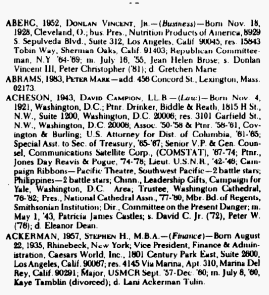
DEER ILAND CLUB
The Order's retreat is the Deer Iland (spelled Iland after the
request of Patriarch G.D. Miller) Alexandria Bay on the St. Lawrence
River, New York. The island was donated in 1906 by Patriarch Miller
and renovated over the years, but particularly in the 1950s and
1980s.
Here's an extract from the latest February 29, 1984, report to
Patriarchs: Deer Iland had another successful year in 1983, the 76th
season of the Club since its establishment under the direction of
George Douglas Miller, D. 68' in 1907. Was it the best year ever?
Maybe. They're getting better and better. The results of the past
five or six years have seen the Club become a much more viable
enterprise from the years of the late '60s and early '70s when its
future was much in doubt.
The positive response made by Patriarchs is seen in the following
paragraph from the same annual report: Increased use of the island
is not the only factor in its present sound financial footing. Your
generosity through your contributions to our annual fund drives has
kept the Club going through lean times and supports it today.
Most recently, the splendid response to the special capital fund
drive in 1981-82, commemorating the 75th anniversary of the Club, has
enabled us to make major capital improvements to our facilities - a
process which is still underway. I should add that those special
contributions are not being used to meet current operating expenses
but are specially designated for capital improvements.
Current
income from all sources - guest receipts, the G.D. Miller trust, and
the annual appeal - has met or exceeded our expenses for seven
years, giving us both welcome security and the means to improve
further the island's classic river-style structures. (I don't want
to use the word "modernize" except perhaps in reference to the
plumbing. You may so inform your wives.)
In brief: the organization of The Order both as Russell Trust
Association and Deer Iland Corporation is essentially geared towards
the post graduation world, the outside world. It is a senior
society. Knights spend only one year as Knights. The rest of their
lives are spent as Patriarchs in an active influential organization
able to guarantee wealth and ambition.
* D. 68 - It is a practice for
members to place their Club identification after their name in
writing each other.
Return to Contents
Memorandum Number Three:
The Ritual of The Order
The ritual of The Order is a closely held secret. The most that
anyone can do at this stage is piece together some elements of the
ritual and their probable meaning.
The extraordinary secrecy is itself part of a ritual. Members are
sworn not to discuss the organization, its procedures or its
objectives. Presumably, only an FBI or Congressional investigation
could break this code of "omerta" (Mafia = silence).
The secrecy is carried to extraordinary lengths. Members may not
remain in the room if The Order is under discussion. Words spoken
within The Order may not be placed on paper, even in letters to
fellow members.
For example, witness the following extract from a
letter circulated to members by W. lain Scott (D. 171), President of
Deer Iland Club Corporation:
But beyond these mere quantitative measures of success, it is the
quality of the Deer Iland experience that commends the Club to your
attention. There are few, if any, places where the B-n-s life
thrives in such luxuriance outside the thick and tomblike walls in
New Haven. Our Order is, to use an economic term, very much
horizontally integrated. That is, our ties to it are strongest
through a very narrow slice of time - one special year.
Deer Iland,
for me and I believe many others, has expanded these ties vertically
through contact with younger and older members. Visitors to the
island last summer ranged from D. 124 to D. 182, twelve of them. It
serves as prelude to the music of the B-n-s for the "newly fledged
exalted K---- ts" and as an endlessly rising canon on that wonderful
theme to "the p-tr--rchs."
Notice three abbreviations to conceal internal use of words from any
possible outsider who may stumble on a copy of the letter: B-n-s
=Bones (cited twice) k---- ts = Knights p-tr--rchs = Patriarchs The
reader may consider this juvenile, and it may well be. On the other
hand, these "juveniles" are the men today running the United States.
Chapter meetings of Patriarchs are announced using a format which
has not changed since the early 19th century. An interesting and
significant aspect of these announcements is the manner in which
they reflect elements of the ritual: the skull and bones, the
periods into which The Order has placed its history and the club
numbers.
We reproduce below announcements for the following years:
-
July 28, 1859 - the earliest year for which we have a copy. Note the
Roman letters VI in the center of the sheet.
-
July 23, 1868 - the last year for which we have a record of the VI
appearing. We understand that 1869 was actually the last year with
VI.
-
July 21, 1870 - the first year with VIII in the center. Note that
VII appears to have been skipped completely.
-
June 17, 1936 - note that the format remains almost the same. This
one was signed by Potter Stewart, later (1958-1981) Supreme Court
Justice.
-
May 31, 1984 - the latest announcement notice. Note that the Club
number D. 183 now appears, but in essence the sheet remains exactly
as in 1859. It appears they even used the same skull and bones.
The
initiation ceremony itself has been partially described in both the
1876 documents (reproduced below) and a century later by Ron
Rosenbaum in "The Last Secrets of Skull & Bones" (Esquire, September
1917).
Each year 15 newly tapped members are put through what has
been described as a "harrowing" ordeal -presumably to test their
manhood - a manner traditional with fraternity hazing. According to
Rosenbaum, "one can hear strange cries and moans coming from the
bowels of the tomb" during initiation.
Four elements of the initiation ceremony are recorded:
-
that the
initiate has to lie naked in a sarcophagus
-
that he is required to tell the
"secrets" of his sex life to fellow initiates
-
that Patriarchs dressed as
skeletons and acting as wild-eyed lunatics howl and screech
at new initiates
-
that initiates are required to wrestle naked in a mud pile.
Undoubtedly there is more.
However, the above is enough to warrant
branding The Order as based on behavior more suited to juvenile
delinquents. Undoubtedly the more serious part of the initiation
process is peer pressure, the conversion of juveniles into
presumably responsible members of an unelected elite.
As Rosenbaum
comments,
"the real purpose of the institution was... devoted to
converting the idle progeny of the ruling class into morally serious
leaders of the establishment."
What happens in the initiation process is essentially a variation of
brain-washing or encounter group processes. Knights, through heavy
peer pressure, become Patriarchs prepared for a life of the exercise
of power and continuation of this process into future generations.
In brief, the ritual is designed to mold establishment zombies, to
ensure continuation of power in the hands of a small select group
from one generation to another.
But beyond this ritual are aspects
notably satanic.
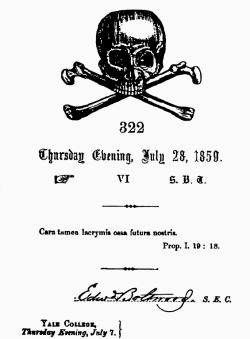 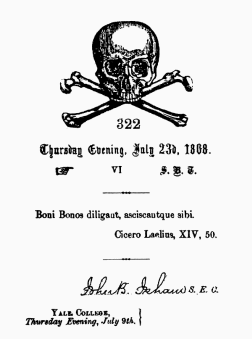
 
Return to Contents
Memorandum Number Four:
Satanic Aspects of The Order
Even with our limited knowledge of the internal ritual of The Order
we can make three definite statements about the links between The
Order and satanic beliefs.
These observations should be seen as a start point for further
research and consideration.
-
The first link is through photographic evidence of the association
of Skull & Bones with satanic devices, i.e., the skull and crossed
bones
-
The second link is through satanic symbolism
-
The third link is through the association of
The Order with
the New
Age Movement, well documented in a remarkable new book by
Constance Cumbey,
The Hidden Dangers of the Rainbow
THE PHOTOGRAPHIC EVIDENCE
Photographic evidence exists of the use of the satanic devices of a
skull and crossed bones in ceremonies of The Order.
We reproduce on the following page a photograph of the "Class of
1869." Fifteen members of the Club, thirteen standing and two
seated, are grouped around crossed thigh bones and a skull. A
handwritten list of these men is also reproduced.
In the background is a grandfather clock. From 1833 to the present
time a grandfather clock is presented to each Knight upon initiation
and stays with him throughout his life as a memento of what is
called "the Bones experience."
We also reproduce two other photographs of other classes seated
around a skull and bones. According to other evidence, at least
three sets of skulls and assorted bones are kept within the Bones
Temple on the Yale campus. An obvious point is that these bones and
skulls are former human beings.
Instead of sacred treatment, they
are exhibited and used for ceremonial purposes. Where the bones
should be resting decently in a grave, they have become the center
of a secret ceremony. In brief, the photographs reveal the men
portrayed as grave robbers who reject human dignity and decency and
use satanic devices.
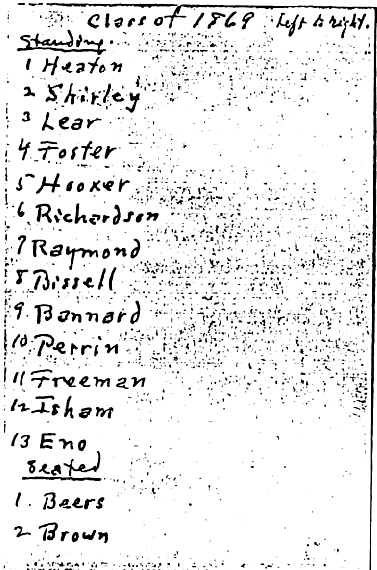
  

THE SATANIC SYMBOLISM OF THE SKULL
Artist Elizabeth Stucki 1 has commented on the mask and the skull in
modern art and the symbolic meaning.
Says Stucki:
"The Skull -
Mortality Unmasked
The opposite of the mask is the skull. The face of the person is a
fleshy skin worn between the two. People who deny the person as made
in the image of God directly, and individually created and loved by
Him, will seek either of these exits to being truly human - the mask
which covers the mortal man or the skull which is left after mortal
man has departed. Primitive minds who have not yet found God and
sophisticates who have rejected Him, desire the mask and the skull."
Collectivist artist Picasso, darling of New York establishment
elitists, was also preoccupied with skulls in a manner very similar
to members of Skull and Bones. The preoccupation is portrayed by
Leo
Steinberg in Art News, October 1971.
Artist Stucki comments on
Picasso's morbid interest in skulls as follows:
In 1945, Picasso painted "Skull and Pitcher." Leo Steinberg states
that in it "the light's character is consistently altered." The
light is as hard as an axe-blade, not softly spiritual. Steinberg
also gives the painting a Freudian interpretation of sexuality and
interprets the pitcher to be the "receiving part in a Satanic
annunciation."
He refers to Morgenstern's poetry on sex and the
skull. In this article he feels that Picasso projected himself into
the skulls. He made eight skulls in one week as a method of
mastering his fear o: death. In 1930, Picasso was self-projecting
into the Minotaur monsters he painted. He had painted skulls all
along; an earlier one in 1907, is in a still-life now in Leningrad.
In the same year, he discarded the idea of using a skull in his
"Demoiselles d'Avignon." In the mid-1940s, he used it as a mask, on
an owl, or on a horse face."
THE HIDDEN DANGERS OF THE RAINBOW
Constance Cumbey in The Hidden Dangers of the Rainbow identifies
several organizations linked to The Order and the objectives of The
Order.
Cumbey identifies Benjamin Creme and the Tara Center based in
New York, Los Angeles, Amsterdam and London as a New Age phenomenon.
To Creme are linked Unity and Unitarian Church leaders. Unknown to
Cumbey, The Order has long-standing and significant links to the
relatively small Unitarian Church. In fact, former President William
Taft, whose father co-founded The Order, was President of the
Unitarian Association in his time.
Cumbey identifies the link between Hitler and the New Age movement
and former research by this author linked The Order to the founding
and growth of Naziism. Most significantly, Cumbey states that the
New Age movement plans to bring about a New World Order "which will
be a synthesis between the U.S.S.R., Great Britain and the United
States." Finally, Cumbey points out that the anti-Christ and
satanic
aspects are woven into the cult of the New Age movement.
The period is constant at "2" while the Decade increases by one each
ten years, i.e., decade 3, 4, 5, etc.
The "D" number is always less than the class number. Up to 1970 by 2
and after 1970 by 1. In other words the first list of members - the
class of 1833 was designated "P. 231-D.31." In brief, the
organization started in the United States was in the third decade of
the second period.
So a sensible question is - where does that place
the start? Presumably in Germany.
The first decade of the second
period would then begin in 1800 and the first period would have
ended in the decade 1790 to 1800. That places us in the time frame
of the elimination of Illuminati by the Bavarian Elector.
1
1 Margaret Elizabeth Stucki, War on Light: The Destruction of the
Image of God in Man Through Modern Art (Available from Freedom
University Press), p. 7.
Return to Contents
Is The Order also
Illuminati?

Reprints of Rare Material of The
Order
Anonymous SKULL AND BONES
No date
An account of the break-in "Bones
Temple"
1876

Let it be stated in advance that this pamphlet is published solely
with a view to clear away the "poppy-cock" which surrounds the
greatest society in college. It has no malicious intent.
The sole
design of the publishers and those who made the investigations, is
to cause this Society to stand before the college world free from
the profound mystery in which it has hitherto been enshrouded and to
lessen, at least in some degree, the arrogant pretensions of
superiority.
Table of Contents:
I. - Methods of Investigation
II. - Description of the Temple
III. - Histology of the Society
Appendix
Plan of the Building
PART I - METHODS OF INVESTIGATION
Any one who was noticing the Bones men of '77, on the morning of
Sunday, Oct. 1st, 1876, was probably struck by the crestfallen air
which characterized them all. As long as Bones shall exist, the
night of September 29th will be to its members the anniversary of
the occasion when their temple was invaded by neutrals, their rarest
memorabilia confiscated and their most sacred secrets unveiled to
the eyes of the uninitiated.
We have thought a description of how
this was done might be of interest to the college world. The back
cellar windows of the eulogian temple were fortified as follows:
First, to one seeking entrance from the outside was a row of one
inch iron bars; behind them was a strong iron netting fastened to a
wooden frame; behind this another row of iron bars 11/a inches
thick; and still behind this a heavy wooden shutter.
Formidable as
these defenses appear, we determined to effect an entrance. The work
proceeded slowly and it was only after many hours of patient work
that one of the outside iron bars was cut into. Next, by means of a
powerful claw, the long nails that fastened the iron netting to the
wooden frame were drawn out.
Then the bar was refastened in it place
by means of a little putty, and we retired to wait a favorable nigh:
for completing the undertaking; 8 o'clock, Friday evening, Sept. 29.
was the time selected. First, one of our number proceeded to remove
the iron bar and netting; and then, for the sake of more room, he,
with considerable difficulty, got out the strong wooden frame to
which the latter had been fastened.
Pushing head and shoulders into
the opening thus made, there still remained a strong row of 11/a
inch iron bars. Fortunately, there was no need to file these
through. They were fastened above in a thick joist, but below, ran
into a brick "damp-wall" that was built up inside and two inches
from the stone foundation of the building By the aid of a hatchet,
it was the work of but a very few moments to dig away about twenty
inches of this wall and thus loosen an iron plate through which the
lower ends of the bars ran.
Upon pushing this plate inward, the bars
all fell out of their own weight; the flimsy wooden shutter was then
wrenched from its position, and, at just half-past ten, an entrance
was effected. Passing in through the window, we broke open the
wooden door at the top of the cellar stairs, opened the two iron
shutters which close the back windows of the main hall and proceeded
to examine the temple at our leisure.
A WARM SUMMER'S NIGHT witnessed the other entrance and the fuller
investigation which enables us to enlighten the hitherto mystified
college world about the interior of the recent addition. It also
supplied the missing links in the history of the society and the
mode of working it, which the previous investigators neglected to
secure.
One day in the Spring, a young man happened to be passing Bones
hall, late Thursday night, and noticed a gleam of light from the
skylight in the roof. Reasoning that where that ray appeared there
must be some entrance, sometime afterwards several public spirited
under-graduates made the exploration we chronicle.
They got a ladder, which the painters who were rejuvenating the old
brick row were using, some stout rope, a dark lantern, a small crow
bar, a hatchet, cold chisel and jimmy. One Sunday night, about
eleven o'clock, they carried the ladder across the campus and placed
it against the rear of the building. One man was stationed across
High Street to act as watchman.
The others ascended the ladder;
previously, however, they took the precaution to remove their shoes
and went up in their stocking feet, to avoid all noise. Going over
the roof to the skylight, they easily pried it open with the crow
bar. The opening would admit them, one at a time. The rope was tied
to the skylight.. Separately, with joy and trembling, the
investigators slide down. They were now in the mystic recesses of
Bones.
As the result of their investigations is summarized with the result
of prior research, we need not go into it more at length here.
Suffice to say that shortly before dawn they climbed the rope,
refastened the skylight, descended to the ground and put the ladder
back where they had got it.
It may be safely said that no hearts in
the whole college were more Joyful and no sincerer thanks went up in
chapel that morning, than from chose daring men, who had taken such
great risks to disclose the inner parts of our Yalensian Juggernaut.
PART II - INTERIOR OF SKULL AND BONES HALL
Besides the cellar the temple is divided into two stories Fig. 1 is
a rough plan of the cellar:
There is always kept burning in the Jo a lamp which is ornamented
with a dilapidated human skull and a framed set of "Directions to
new Eulogians." The kitchen is well appointed, and the furnace a new
one. Each dish on the kitchen shelves is ornamented with the skull
and bones. Each spoon and fork is marked S.B.T.
On ascending the stairs from the cellar, you find yourself, after
bursting open the door C, in a entry, from which a winding staircase
(M leads to the upper floor. The door C is of wood, but broken open
easily.
H is the outside iron door covered on the inside with a pair of
light frame doors. 8 is a small toilet room. D opens into the lodge
called 324. is fitted up in black velvet, even the walls being
covered with that material. A glass case here holds quite a quantity
of memorabilia -among which may be seen a hat said to belong to
Pret. Pierson, a number of base balls and several textbooks.
G
contains two side-boards of mahogany and one large table in the
center. Besides these the walls are adorned with pictures of the
founders of Bones at Yale, and of the members of the Society in
Germany, when the Chapter was established here in 1832' There are
also two smaller tables. The glassware, decanters; & c., on the
side-board, all have the skull and the bones blown into the glass.
Ascending to the next floor, we come into a long hall (F) . Entering
room A immediately on the left is seen a book-case which contains
the Bones library and which is very complete, containing about every
book of note ever published at Yale. Hanging on the wall toward High
street was a handsomely-framed cushion of velvet on which were
fastened the pins of every society ever in Yale University.
On the
south side of the room is a handsome open fireplace and above this a
marble mantel a: and a mirror. On the mantel were two casts of the
pin; one in silver and the other in bronze - the first about two
inches in diameter, the second about three. Several mystical
engravings hung on the walls. The room a handsomely furnished.
Tobacco, pipes and cards are abundant.
Room B, called 322, is the "sanctum sanctorum" of the temple. Its
distinguishing feature is a facsimile of the Bones pin, handsomely
inlaid in the black marble hearth, just below the mantel, and also
inlaid in marble is the motto: "Rari Quippe Boni," in old English
text. This room is furnished in red velvet, and is very luxurious.
On the wall is a star with a finger pointed towards it.
On the walls
of the long hall F are hung groups of pictures of each Bones' crowd.
H is an old plain lock safe. but contained nothing save a knife
covered with blood stains. C is memorabilia room, and contains the
old college bell, old boating flags old mss.,&c. D contains two
Brunswick & Balke combination tables (billiard) and a 'bouffe',
beside cue racks &c. E is a Jo and toilet room.
PART III - HISTOLOGY OF THE SOCIETY
Bones has no constitution. Its grip &c., are handed down from
fifteen to fifteen. The records though, which are made at each
meeting, show all anybody could want to know. These records are
profusely illustrated, making an interesting memorial to future
Eulogians. Some well-skilled amateur has evidently spent much time
illustrating them. The motto "Boni bonis adpacunt" constantly
appears.
Bones is a chapter of a corps in a German University. It should
properly be called, not Skull and Bones Society, but Skull and Bones
Chapter. General R--, its founder, was in Germany before Senior Year
and formed a warm friendship with a leading member of a German
society. He brought back with him to college authority to found a
chapter here. Thus was Bones founded.
The 322 on the pin has been
commonly supposed to mean, founded in '32 and 2nd chapter. But the
Bones man has a pleasing fiction that his fraternity is the
descendant of an old Greek patriotic society, dating back to
Demosthenes 322, B.C. .he Bones records, 1881 for example, with huge
pride, are headed Anno-Demostheni 2203. A secondary date is from the
time of the fire in the hall or anno conflagrationis, as the records
style it.
Immediately on entering Bones, the neophyte's name is changed. He s
no longer known by his name as it appears in the college catalogue,
but, like a monk or knight of Malta or St. John, becomes Knight so
and so. The old Knights are then known as Patriarch so and so. The
outside world are known as Gentiles and vandals. We have tried to
prepare this brief sketch without injuring the feelings :r
susceptibilities of any PERSON.
It has been done through an earnest
belief that Bones, as at present conducted, is a blight on Yale
College. It makes bitter the time when all should be pleasing. It
forms emities and creates discussions when all should be harmony.
But, above all, it lowers our standard of honor and detracts from
that manliness which is our pride.
APPENDIX
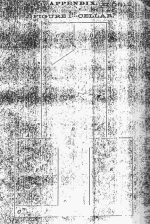 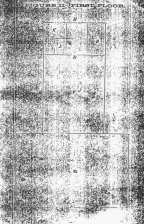 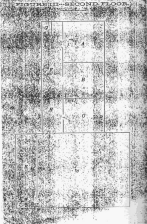
Return to Contents
Anonymous THE FALL OF SKULL AND BONES
Published by The Order, New
Haven 1876
Satirical essay
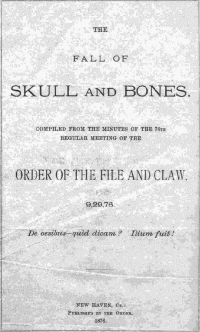 
BABYLON IS FALLEN
Anyone who was noticing the Bones men of '77 on the morning of
Sunday October 1st, 1876., was probably struck by the crest-fallen
air which characterized all of them. At any rate there were those
who observed that during the church services their eyes suspiciously
scanned the faces of one neutral after another, and invariably
dropped if their glance was returned.
The reason for this is a
simple one. As long as Skull and Bones Society shall exist, the
night of September 29th will be to its members the anniversary of
the occasion when their Temple was invaded by neutrals, some of
their rarest memorabilia confiscated, and their most sacred secrets
unveiled to the vulgar eyes of the uninitiated.
We have thought that a description of how this was done might be of
interest to the college world. The back-cellar windows of the
Eulogian Temple were fortified as follows:
First, to one seeking entrance from the outside, was a row of one
inch iron bars; behind them a strong iron netting fastened to a
wooden frame; behind this another row of iron bars, one and one
quarter inches thick; and still behind this a heavy wooden shutter.
Formidable as these defenses appear, the Order of the File and Claw,
having procured a supply of files, skeleton keys, etc., determined
to attempt to effect an entrance. For reasons that need not be
rehearsed here, the work proceeded slowly, and it was only after
many hours of patient and cautious labor that one of the outside
bars was cut in two.
Next, by means of a powerful claw, the long
nails that fastened the iron netting to the wooden frame were drawn
out. Then the bar was re-fastened in its place by means of a little
putty, and we retired to await a favorable night for finishing the
job. Eight o'clock Friday evening, September 29th, was the hour
selected.
First, one of our number proceeded to remove the iron bar and the
netting, and then, for the sake of more room, he, with considerable
difficulty, got out the strong wooden frame to which the latter had
been fastened. Pushing head and shoulders into the opening thus made
there still remained a strong row of one and one quarter inch iron
bars Fortunately there was no need to file through these.
It was
found that they were fastened above in a thick joist, but below ran
into a brick "damp-wall" that was built up inside, and two inches
from the stone foundation-wall of the building. By the aid of a claw
and a hatchet. It was the work of but a few moments to dig away
about twenty inches of this wall, and thus loosen an iron plate
through which the lower ends of the bars ran.
Upon pushing this
plate inward, the bars all fell out with their own weight; the
flimsy wooden shutter was then easily wrenched from its position,
and at just half past ten o'clock an entrance into the cellar was
obtained. Passing in through the window, we broke open the wooden
door at the top of the cellar stairs, opened the two iron shutters
which close the back windows of the main hall, and proceeded to
examine the Temple at our leisure.
For the benefit of future
explorers, and as a directory for new-fledged Bones men for all
time, we will now give a brief description of
THE INTERIOR OF SKULL AND BONES HALL
Besides the cellar, the Temple
is divided into two stories. Fig. 1 is a rough plan of the cellar:

A light is always kept burning in the Jo (D), which is ornamented
with a dilapidated human skull and a framed set of "Directions to
Freshmen," signed Thomas Clap, and dated Yale College, 1752. Here is
also a tombstone marked Sperry, seemingly taken from the same grave
as the skull.
On the west wall of the kitchen (E), which contained
the ordinary conveniences, hangs a picture of Napoleon Bonaparte. In
the Pantry (F) are large quantities of dishes, each piece of
crockery ornamented with a picture of a skull and crossbone and each
spoon and fork marked. S.B.T.
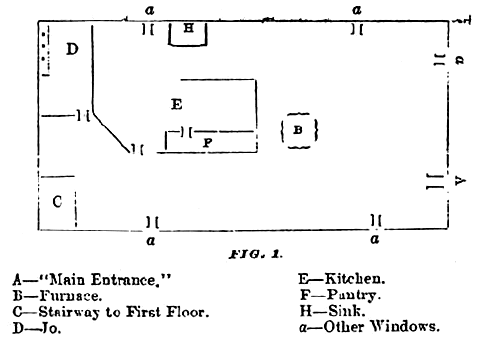
On ascending the stairs from the cellar, you find yourself, after
bursting open the door C, Fig. 2, in an entry (A), from which a
winding staircase (K) leads to the next floor. The door C, which is
of wood, we found locked, but broke open without difficulty. H is
the outside iron door, covered on the inside with a pair of light
frame doors. B is a small toilet room.
The door D, which is without
a lock, opens into the main hall (F), called by the initiated "324".
The floor is of colored tiles; the walls are rather gaudily
frescoed, mainly in red and black, somewhat like those of D K hall.
A few settees, resembling those in Linonia Hall, and a table, make
up the furniture of the room. The wood work is painted white, and,
like the walls, is in many places scratched and dirty.
EE are two
narrow windows, guarded by strong iron shutters. The latter are
concealed from view by some light wooden blinds stained to look like
walnut. The only objects of interest in the room were a glass case
in the southeast corner containing a large number of gilded
base-balls, each inscribed with the date, score, etc., of a
university game, and a well-thumbed text-book, either a Physics or a
Human Intellect, on the fly-leaf of which was inscribed the
autograph of Bones' irrepressible annoyer, Arjayjay of '76.
Thus far
we had found little to compensate us for our trouble, but on
ascending to the next floor, and passing, on our right a little
store-room and draw-bridge which extend over the front entrance from
High Street, our pains was rewarded.
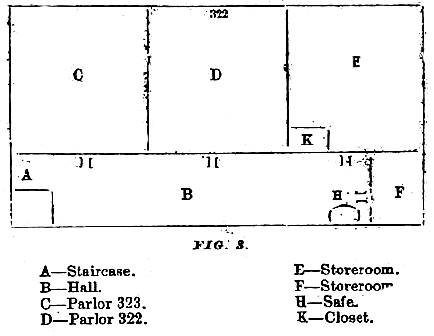
Entering the room C, Fig. 3, immediately on the left is seen a
bookcase, which contains the Skull and Bones library, including a
complete set of the Yale Lit., handsomely bound college catalogues
and books published by Bones men. Here, too, was the Constitution of
the Ph Beta Kappa and a catalogue of Scroll and Key Society,
containing a list of members down to 1868.
It was bound in black,
and had on the front cover the letters C.S.P. and on the back C.C.J.
In Old English text. For -he year LI only eleven names are given,
and for XLII only twelve. It contains several typographical errors,
as for instance; D. Cady Eaton's first name is printed Samuel.
Opposite the names of the first two Keys men for LXII, some one has
written, in a bold hand, the mystic symbol "Ass".
And at the top of
the page which give the men of LII, is written, "Croud packed by
Boies," and Boies is the name of a Keys man of that :ear. From the
catalogues we learn that the President and Secretary of Scroll and
Key are known "inside" as Chilo and Eumenes, and that, as n Bones,
each member has a nickname given him. Some of these are handed down
from class to class, of these Glaucus, Prisaticus and Arbaces appear
to be the favorites.
Hanging on the wall towards High street was a handsomely-framed
cushion of dark velvet, on which were fastened the pins of all the
societies which have existed in college, including Spade and Grave,
Bull and Stones, and the like.
On the south side of the room is a
fireplace, and above this a mantel and mirror. Upon the mantel were
a Skull and Bones of silver, the skull about two inches in diameter,
and engraved "32 from the S.E.C. of 1858;" another of bronze, a
little larger than the silver one, and various other insignia
relating to Skull and Bones.
On the west wall hung, among other
pictures, an old engraving representing an open burial vault, in
which, on a stone slab, rest four human skulls, grouped about a
fool's-cap and bells, an open cook, several mathematical
instruments, a beggar's scrip, and a royal crown.
On the arched wall
above the vault are the explanatory words, in Roman letters,
"We War Der Thor, Wer Weiser, Wer Bettler Oder Kaiser?"
and below the vault
is engraved, in German characters, the sentence;
"Ob Arm, Ob Beich, im Tode gleich"
The picture is accompanied by a card, on which is written, "From the
German Chapter. Presented by Patriarch D.C. Gilman of D. 50" The
room is handsomely furnished; tobacco and pipes were abundant, and
packs of well worn cards served to indicate how the society manages
to fill five or six hours every Thursday evening.
The pipe-bowls,
which are representations of skulls, and bear the stamp of M.
Gambier, Paris, nave the Eulogian name of the owner and his decade
written upon .hem with red ink; for instance the one belonging to
the present Member from Bath" was marked "Trim, D. 75."
Room D, the Bones name of which is "322," is the
sancta sanctorum
of the Temple. Its distinguishing feature is a life-size facsimile
of the Bones pin handsomely inlaid in the black marble hearth. Just
below the mantel, and also inlaid in marble, is the motto:
Bari Quippe Boui
...in old English text. This room is even more richly furnished than
"323", but contains no book-case, and no pictures of special
significance.
On the walls of the long hall B are hung a couple of score of
photographs, about 12x20 inches, each representing fifteen Bonesmen
grouped around a table, on which rest a human skull and crossbones.
As the finish of these pictures is poor and of an antiquated style,
it is probable that they are taken each year with the apparatus
belonging to the society.
H is an old-fashioned plain-lock safe,
size about 20x26 inches, and 15 inches deep, set in the wall. It is
probably used as a place of deposit for money and valuables, but on
the night of the 29th contained only a bunch of keys and a small
gold-mounted flask half filled with brandy.
K is a small closet in which are kept unbound sheets of the Bones
Society catalogues and a set of handsome memorable books, one for
each year. Some of the old memorable is quite curious, and the
collections relating to recent years are very complete.
The Bones catalogue is essentially as described in Four Years at
Yale.
The doors to E and F, which are used as general storerooms, are
protected by plates of sheet-tin, but the locks were not "what we
may call" proof against skeleton keys. The memorabilia in these
rooms was noteworthy for amount rather than quality. However, in the
midst of a good deal of rubbish we found four or five boating flags,
and a number of old Greek, Latin and German works in MS. None of
these were society records, but works of well-known authors; into
the genuine antiquity of the MSS. We have not as yet been able to
examine.
In conclusion, we will say that a thorough examination of every part
of the Temple leads us to the conclusion that "the most powerful of
college societies" is nothing more than a pleasant convivial club.
The kitchen contains the materials for serving refreshments for the
inner man; there are neither billiard tables nor any kind of musical
instrument in the building; there is a total absence of all the
"machinery" which we had been led to expect; the bell heard on
initiation nights is not "the old college bell;" Skull and Bones has
no secrets beyond a few that may be handed down annually by word of
mouth, and no written constitution beyond -a few directions similar
to the suggestions appended to the Delta Kappa by-laws.
Before
leaving the hall, it was asked whether we should inform other
members of the college of what we had done, and throw open the hall
to the public. We think no one will deny that we had it in our power
at one stroke not only to take away forever all the prestige which
her supposed secrecy has given this society, but to make her the
laughing-stock of all college, and render her future existence
extremely doubtful.
But while we had no consideration for the
mysterious poppiecock of Skull and Bones Society, we nevertheless
remembered that some of the Bones men of '77 are our warm personal
friends, and therefore we preferred a less radical course. To Bones
as a pleasant convivial club, we have no objections. Let her live on
as long as men enjoy good suppers and quiet whist. But her mystery
and her secrecy are at an end, and we hope her absurd pretensions
and her poppiecock are dead also.
The burglary was not discovered until the following evening, at
about eight o'clock. All day Saturday the great Skull and Bones lay
at the mercy of any one who might notice the back window.
How thoroughly the society was frightened can be seen by the way
they have sealed up the window through which we entered, as well as
more recently all of the other five basement openings. We have no
idea that Skull and Bones will deny that their hall has been
entered, for we are not without proofs that our tale is true. We
have above spoken of different manuscripts, trinkets and memorabilia
as existing in the Temple.
In several cases we should have written
"existed" for the place that knew them shall know them no more
forever. In short, while robbery was not our errand, on the
principle that the second thief is the best owner we helped
ourselves to a few pieces of memorable, which can be put on
exhibition, and a few documents which can be printed, should any
authoritative denial be made to any essential point in this
statement. Nor will Bones usual policy of silence avail to throw
discredit upon our story.
Part of our memorable has been seen by
Senior neutrals, and the remainder will be put where it will do the
most good, as soon as the protection of a sheepskin has been placed
between us and the Faculty and the law.
YALE COLLEGE
1877
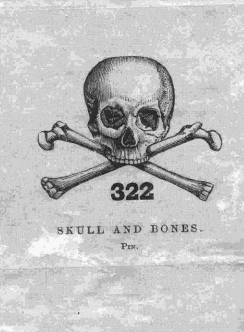 
Return to Contents
|


























